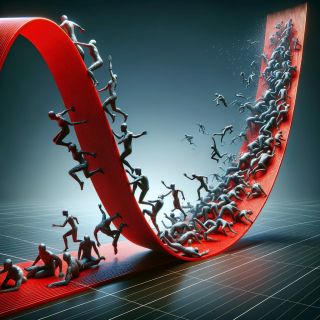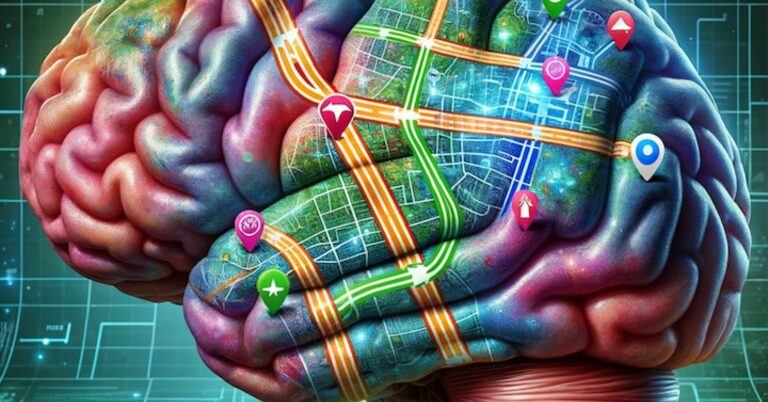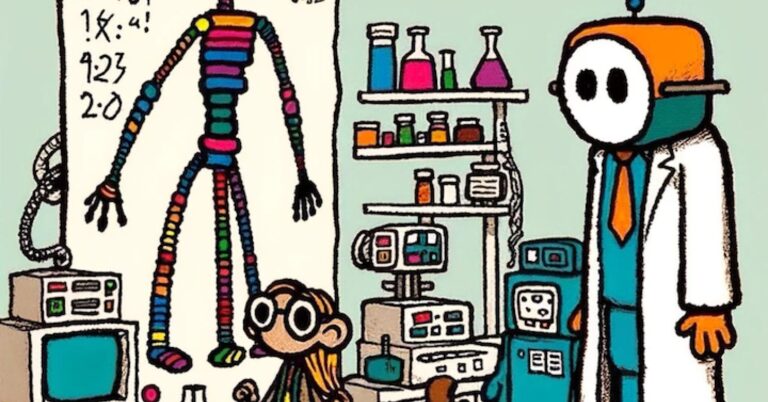
Source: Art: DALL-E/OpenAI
In the cacophony of innovation, something is amiss. The alignment of technology—particularly AI—with humanity seems to be the witty slogan of the day. And it’s articulated as if two puzzle pieces are effortlessly matched to form a seamless union.
Yet a closer inspection reveals two distinct actors take the stage: Humanity, with its linear, incremental journey, and Technology, with its exponential sprint. Let’s explore the intricate dance between these two forces, delving into the nature of human cognition and the relentless surge of technological advancement.
Humanity: The Linear Traveler
At the heart of our story is Humanity, a character generally defined by gradual, linear progression. This linearity is not just a geometric metaphor but a reflection of our cognitive, emotional, and societal evolution.
Cognitive Constancy—Human cognition, deeply rooted in the structures of our brain like the limbic system, has maintained a consistent pace over millennia. Our emotional responses, learning processes, and memory formations follow a path that is more evolutionary than revolutionary. While individual learning can display moments of rapid growth and adaptation, the overall cognitive development of our species unfolds across generations.
Societal Change: A Steady March—Similarly, societal change, guided by cultural norms and collective learning, moves at a deliberate pace. It’s a journey marked by the slow accumulation of knowledge, gradual shifts in values, and methodical policy transformations. This pace is inherently linear—a continuous, steady march forward, occasionally punctuated by significant events but largely defined by constancy and gradualism.
Technology: The Exponential Challenger
Enter Technology, the second protagonist in our story. It’s a force characterized by rapid, often disruptive growth, especially in the realm of AI and digital innovation.
The Exponential Curve of Innovation—Unlike Humanity, Technology doesn’t follow a straight path. Its journey is exponential, each advancement building on the last at an ever-increasing rate. This pace is not just fast; it’s accelerating, creating a curve that grows steeper with each passing year.
Pushing Boundaries: A New Mathematics—This exponential growth pushes Humanity out of its linear comfort zone. It introduces a ‘new mathematics’ into the equation of existence—a mathematics where change is not incremental but transformative, where the next step might not be a step at all, but a leap into the unknown.
The Intersection: Humanity Meets Technology
The crux of our narrative lies at the intersection of these two paths. Here, the steady line of human evolution meets the soaring curve of technological advancement.
Out of the Comfort Zone—This meeting point is more than just a crossroad; it’s a frontier where Humanity is pushed beyond its traditional linear trajectory. The rapid advancements in technology challenge our cognitive and societal frameworks, forcing us to reevaluate our methods of learning, adapting, and governing.
The Dilemma of Adaptation—As Technology races ahead, it leaves Humanity with a dilemma: How do we adapt to a pace of change that is fundamentally different from our evolutionary and historical experience? This question is not just about adopting new gadgets or systems; it’s about reshaping our cognitive and societal frameworks to accommodate a new reality.
An Insurmountable Asymmetry?
In this narrative, we find not just a tale of contrast, but a blueprint for a future where humanity and technology co-evolve, each enriching the other in their journey forward. However, the conclusion warrants a more sober reflection on the stark reality of this interplay.
As the irresistible force of innovation accelerates, meeting the seemingly immovable object of humanity, we encounter a profound disconnect. This isn’t a challenge that can be remedied by the comforting notions of balance or harmony between man and machine. It is a more serious, perhaps even intractable problem.
The asymmetry between the linear progression of humanity and the exponential surge of technology has reached a juncture where simple adjustments and alignments are no longer sufficient. Our institutions, governance, and even our global consciousness lag far behind the breakneck pace of technological advancements. The tools we possess for understanding and managing this growth are quickly becoming outdated, much like trying to navigate a modern digital landscape with a map drawn in the age of sail.
The question looms large: Can humanity ever truly catch up, or are we destined to be perpetually outpaced? The human spirit is resilient and adaptive, but the sheer scale and speed of technological change may have outstripped our ability to integrate it meaningfully into our lives without significant dissonance.
The technological and social exchange between technology and humanity, then, is not one of seamless steps but of discordant rhythms. It is less a waltz and more a complex, improvised piece where the music and movements are in constant flux. The linear and the exponential are not so much merging in harmony as they are colliding, leaving us in a state of curious concern.
This intersection, where the force of innovation meets the solidity of humanity, is not a crossroads with clear directions. Instead, it resembles an intricate maze where every turn brings new challenges and the path behind is constantly eroding. It is a sobering reminder that the future is not a simple extension of the past or the present.
In the final analysis, the potential for an unbridgeable chasm exists. It is a chasm not of technology itself but of the capacity for human society to keep pace with the changes it brings. Without a renaissance in our thinking, in our institutions, and in our collective approach to innovation, we may find that this disconnect is not merely a problem to be solved but a new reality to be lived.
This discussion does not conclude with a tidy resolution but with a call to recognize the magnitude of the challenge we face. It is an invitation to engage with the complexities of this epochal shift, to think deeply about what it means to be human in an age of unfathomable technological progress, and to confront the possibility that some aspects of this divergence may indeed be unfixable with our current tools and mindsets. It is a curious concern, one that we must face as we as we ride the exponential curve of change yet clutching some of the very things that make us human.





















+ There are no comments
Add yours